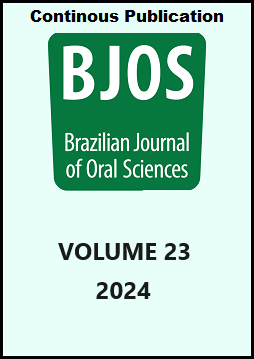Abstract
Aim: This study aimed to assess the polymerization effectiveness of bulk-fill composite resins in longitudinal microhardness. Methods: Blocks of bulk-fill composite resin with thicknesses of 6 mm were analyzed with Vickers microhardness. The resin blocks were divided into two groups (n=6): resin AURA and OPUS. The microhardness test was performed before (base and top) and after (longitudinal microhardness) sectioning the blocks at distances of 2 mm, 4 mm, and 6 mm from the top of the block. The mean microhardness values were tabulated and subjected to ANOVA followed by Tukey’s test (p<0.05). Results: The OPUS bulk-fill resin samples presented microhardness means of 55.9 kgf/mm2, 53.7 kgf/mm2, and 49.3 kgf/mm2, the AURA bulk-fill resin samples presented microhardness means of 57,02 kgf/mm2, 55,86 kgf/mm2 e 51,77 kgf/mm2 for the distances of 2 mm, 4 mm, and 6 mm, respectively. Tukey’s statistical test showed a significant difference in microhardness values at different distances of 2 mm, 4 mm, and 6 mm (p<0.001) for each resin. Although there was a statistically significant difference within and between the groups assessed, all samples showed polymerization effectiveness when comparing the top and base of the block. Conclusion: Polymerization was effective in different thicknesses (2 mm, 4 mm, and 6 mm) in both resins studied. The microhardness ratio was adequate when comparing the base and top.
References
Manhart J, Kunzelmann KH, Chen HY, Hickel R. Mechanical properties and wear behavior of light-cured packable composite resins. Dent Mater. 2000 Jan;16(1):33-40. doi: 10.1016/s0109-5641(99)00082-2.
Sakaguchi RL, Peters MC, Nelson SR, Douglas WH, Poort HW. Effects of polymerization contraction in composite restorations. J Dent. 1992 Jun;20(3):178-82. doi: 10.1016/0300-5712(92)90133-w.
Krejci I, Planinic M, Stavridakis M, Bouillaguet S. Resin composite shrinkage and marginal adaptation with different pulse-delay light curing protocols. Eur J Oral Sci. 2005 Dec;113(6):531-6. doi: 10.1111/j.1600-0722.2005.00259.x.
Rothmund L, Reichl FX, Hickel R, Styllou P, Styllou M, Kehe K, et al. Effect of layer thickness on the elution of bulk-fill composite components. Dent Mater. 2017 Jan;33(1):54-62. doi: 10.1016/j.dental.2016.10.006.
Ilie N, Keßler A, Durner J. Influence of various irradiation processes on the mechanical properties and polymerisation kinetics of bulk-fill resin based composites. J Dent. 2013 Aug;41(8):695-702. doi: 10.1016/j.jdent.2013.05.008.
Roggendorf MJ, Krämer N, Appelt A, Naumann M, Frankenberger R. Marginal quality of flowable 4-mm base vs. conventionally layered resin composite. J Dent. 2011 Oct;39(10):643-7. doi: 10.1016/j.jdent.2011.07.004.
Alrahlah A, Silikas N, Watts DC. Post-cure depth of cure of bulk fill dental resin-composites. Dent Mater. 2014 Feb;30(2):149-54. doi: 10.1016/j.dental.2013.10.011.
Winchell H. The knoop microhardness tester as a mineralogical tool. Am Mineral 1945;30:583-95.
Leprince JG, Palin WM, Hadis MA, Devaux J, Leloup G. Progress in dimethacrylate-based dental composite technology and curing efficiency. Dent Mater. 2013 Feb;29(2):139-56. doi: 10.1016/j.dental.2012.11.005.
El-Safty S, Akhtar R, Silikas N, Watts DC. Nanomechanical properties of dental resin-composites. Dent Mater. 2012 Dec;28(12):1292-300. doi: 10.1016/j.dental.2012.09.007.
Karacolak G, Turkun LS, Boyacioglu H, Ferracane JL. Influence of increment thickness on radiant energy and microhardness of bulk-fill resin composites. Dent Mater J. 2018 Mar;37(2):206-13. doi: 10.4012/dmj.2017-032.
Silva JM. [Knoop microhardness of single-increment bulk-fill resins]. In: XV Seminário PIBIC/UMESP de Pesquisa - V Seminário PIBITI/UMESP. Methodist University of São Paulo; 2019. Available from: http://www.metodista.br/congressos-cientificos/index.php/CM2018/SEMINARIOPIBIC-BIBITI/paper/view/9934. Portuguese.
Esteves JCG. [Analysis of microhardness and degree of conversion of Bulk Fill composite resins] [master's degree]. Lisboa: Faculty of Dental Medicine, University of Lisbon; 2015. Available from: https://repositorio.ul.pt/bitstream/10451/25437/1/ulfmd03064_tm_Joana_Esteves.pdf. Portuguese.
Briso AL, Tuñas IT, de Almeida LC, Rahal V, Ambrosano GM. Effects of five carbamide peroxide bleaching gels on composite resin microhardness. Acta Odontol Latinoam. 2010;23(1):27-31.
Cruz JMMS. [Analysis of microhardness in different composite resins] [master's degree]. Lisboa: Faculty of Dental Medicine, University of Lisbon; 2013. Available from: https://repositorio.ul.pt/bitstream/10451/25438/1/ulfmd03052_tm_Joana_Cruz.pdf. Portuguese.
Fleming GJ, Awan M, Cooper PR, Sloan AJ. The potential of a resin-composite to be cured to a 4mm depth. Dent Mater. 2008 Apr;24(4):522-9. doi: 10.1016/j.dental.2007.05.016.
Orłowski M, Tarczydło B, Chałas R. Evaluation of marginal integrity of four bulk-fill dental composite materials: in vitro study. ScientificWorldJournal. 2015;2015:701262. doi: 10.1155/2015/701262.
Meereis CT, Leal FB, Lima GS, de Carvalho RV, Piva E, Ogliari FA. BAPO as an alternative photoinitiator for the radical polymerization of dental resins. Dent Mater. 2014 Sep;30(9):945-53. doi: 10.1016/j.dental.2014.05.020.
Singhal S, Gurtu A, Singhal A, Bansal R, Mohan S. Effect of different composite restorations on the cuspal deflection of premolars restored with different insertion techniques- an in vitro study. J Clin Diagn Res. 2017 Aug;11(8):ZC67-70. doi: 10.7860/JCDR/2017/20159.10440.
Guiraldo RD, Consani S, Consani RL, Berger SB, Mendes WB, Sinhoreti MA. Light energy transmission through composite influenced by material shades. Bull Tokyo Dent Coll. 2009;50(4):183-90. doi: 10.2209/tdcpublication.50.183.
Par M, Lapas-Barisic M, Gamulin O, Panduric V, Spanovic N, Tarle Z. long term degree of conversion of two bulk-fill composites. Acta Stomatol Croat. 2016 Dec;50(4):292-300. doi: 10.15644/asc50/4/2.
Ilie N. Impact of light transmittance mode on polymerisation kinetics in bulk-fill resin-based composites. J Dent. 2017 Aug;63:51-59. doi: 10.1016/j.jdent.2017.05.017.
Arimoto A, Nakajima M, Hosaka K, Nishimura K, Ikeda M, Foxton RM, et al. Translucency, opalescence and light transmission characteristics of light-cured resin composites. Dent Mater. 2010 Nov;26(11):1090-7. doi: 10.1016/j.dental.2010.07.009.
Ilie N, Bucuta S, Draenert M. Bulk-fill resin-based composites: an in vitro assessment of their mechanical performance. Oper Dent. 2013 Nov-Dec;38(6):618-25. doi: 10.2341/12-395-L.
Costa DD. Influence of translucency and type of composite resin particles on microhardness [course conclusion work]. Dentistry Course, Health Sciences Center, Federal University of Santa Catarina; 2011. Available from: https://repositorio.ufsc.br/handle/123456789/121058.
Caneppele TMF, Bresciani E. [Bulk-fill resin composites – The state-of-the-art]. Rev Assoc Paul Cir Dent.2016;70(3):242-8. Portuguese.
Reis AF, Vestphal M, Amaral RCD, Rodrigues JA, Roulet JF, Roscoe MG. Efficiency of polymerization of bulk-fill composite resins: a systematic review. Braz Oral Res. 2017 Aug;31(suppl 1):e59. doi: 10.1590/1807-3107BOR-2017.vol31.0059.

This work is licensed under a Creative Commons Attribution 4.0 International License.
Copyright (c) 2024 Fernanda Santos Araújo, Wilton Mitsunari Takeshita, Regiane Cristina do Amaral, Adriano Augusto Melo de Mendonça


